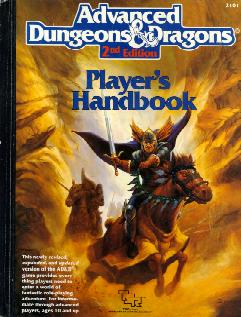So after a session of MERP, this new gaming group introduced me to the most popular RPG on the planet – Advanced Dungeons & Dragons.

AD&D was such a sprawling game, that I’m going split this up as during the time I was playing AD&D, I played and ran such a wide variety of campaign systems that they deserve some comment of their own. Today, just some comments on the game itself.
AD&D 2nd Edition came out in 1989, I didn’t start playing until 1993, but that 1989 date is pertinent. Effectively the second edition is a document of TSR’s needless contrition to the 80’s witchhunt from Christian groups and spurious psychological claims that dogged them throughout that decade. The 2nd edition purged all references to devils and demons, and significantly toned down the artwork to try and placate criticism.
Backing down like this never works out well for the person backing down. The right move would have been to ride the storm of controversy and fight the criticism. There was an opportunity to become an anti-establishment subculture here and use the furor to sell more games. Instead, like the US comics industry in the 50’s, they kowtowed to their critics and cemented themselves as pawns to the establishment. Three years later a merger in the small press gaming world, would create a true anti-establishment gaming company. But we’ll get to them later.
The rules themselves were fine at the time. In retrospect, they are full of logical contradictions, albeit ones that long time D&D players were intensely fond of. Mainly they fondly remember the combat rules that revolved around the classic acronym THACO (To Hit Armor Class Zero).
The rule books were fairly horribly laid out, but fairly typical of American publishing – I remember seeing US console magazines in 90-91 and being bewildered by the poor typesetting they’d have, particularly compared with UK and Japanese magazines, they felt more alien to us as British readers than the magazines that read back to front in a language we couldn’t read, such is the power of layout.
However they way they replaced their “Monster Manual” from the first edition was a masterstroke of layout and design. The Monstrous Compedium was a ring binder containing sheets of monsters, normally one monster to a page. You could find the information with ease, and didn’t need to take a whole book with you to wherever you were playing the game. Of course later on they’d go back the old style monster manual in the sort of double dipping that must have played some part in TSR’s financial downfall.
Artwise it was the usual clash of styles that characterised TSR material at this time. It often felt like uncommissioned fantasy art that they’d purchased, rather than work created specifically for books. I’ll be coming back to TSR’s terrible handling of art in a later installment.
I’m probably being over-critical due to disillusionment created by TSR’s handling of the product line, and 3rd Edition that Wizards of The Coast released (yup, I’ll be getting to this too, very later). At release, and through the early years, this edition was very successful. And you can still have fun times with the rules, and definitely fun times with some of the material published for it, which I’ll start to get at next.